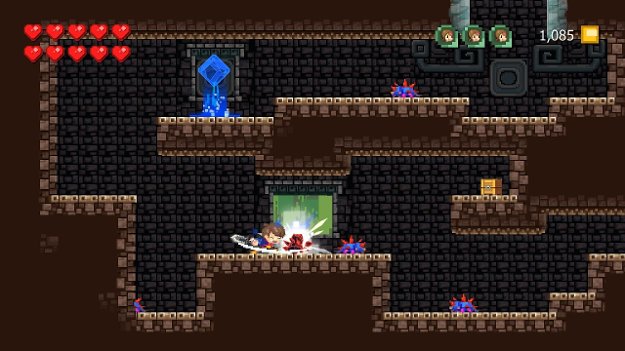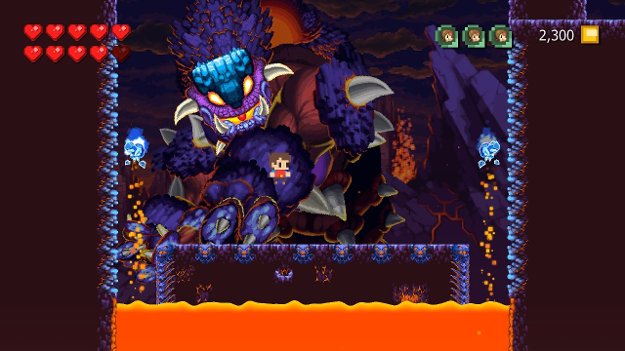As an admitted cynic I find myself getting angry with all of these indie games using pixel graphics. If they were using them for stylized sprite purposes or because doing so saves memory on what could be a complicated game, I woudln’t complain about it. But in many cases it just feels like laziness. The developers could have put together something that looked as good as it played but they decided to settle for the easiest thing they could do, something I strongly object to.
With this in mind I was a bit leery of starting Adventures of Pip. However I’m very glad I was able to move past my initial worry since Pip does some cute and clever things with the idea. It’s not about laziness or even what the developers couldn’t do, the idea of pixels is something that is deeply ingrained in every aspect of this game. See, Adventures of Pip takes place in a world that is all about its pixels. The more pixels that you have, the more highly thought of you are. Of course people like the Royal Family are the best of the best: full 16-bit sprites. Around town you’ll regularly see 8-bit sprites and even what appear to be a 2 or 4-bit sprite, I’m not entirely sure. Pixels even seem to be the currency used by the kingdom to hammer home even further how important pixels are to the people of this land.

Enter Pip, a brave but disadvantaged single pixel who can only wiggle along or jump. He embarks on a quest to rescue the Princess who has been kidnapped by the evil Queen DeRezzia but what chance does one lonely little pixel have? Well Pip very quickly gains exactly what he needs in the form of the ability to tap into the BitStream. This force of energy permeates the world and the Princess, born with access to it, can use the BitStream to create monsters from nothing. But Pip gains the ability to evolve like he’s a freaking Pokemon or something.
By defeating enemies with a glowing blue appearance to them Pip absorbs the BitStream energy they release, upgrading him to a more powerful form. When he gains the first bit of energy he transforms into an 8-bit character. What with having a full body now his abilities are quite upgraded giving him the ability to punch / kick enemies and wall jumping. He can even cling to ledges to make navigating easier. You can even take in a second dose of energy to evolve to a full on 16-bit sprite. Here he gains a sword that he can use to shatter blocks in his way but he loses the ability to wall jump.
All of this is basically designed to be used to solve the various puzzles laid out before him. So when you need to get through a small gap you’ll go back to your single pixel. Need to use your wall jump up a thin corridor? Well that’s what the 8-bit form is for. See a purple barrier? Well you need to de-evolve and use the energy burst this releases to shatter it. But better than that is what this game does with these mechanics. See an idea like this has been used in other games before but what really piqued my interest was how the each of the forms has its own physics to it.

Each form carries its own weight and resistance to the various puzzle elements that make up each stage. Essentially the less pixels you have, the less weight / resistance you have so you’re going to be juggling your choice of form based on this element as well as what capabilities you’ll need. So when you need to use a vertical wind blast to get higher you’ll need to use the pixel since the other forms are too heavy. But the pixel is so light that a horizontal wind burst will push it around too much so you’ll have to swap to a heavier form. As the levels get more complex you’ll find yourself bouncing off of enemies, gaining shapes, de-evolving to clear barriers and shifting forms constantly in rapid succession to clear a stage.
These mechanics make for a very easy to pick up and play sort of game that is hard as hell to master. Early on it won’t be much of an issue but the later stages start getting more and more difficult. Stages start putting more spikes that deal two damage instead of one all over the walls, you’ll get smushed by moving walls or die in a pit of lava. The constant deaths will become relentless until you really start to master what the various stages are asking of you.
What prevents these relentless deaths from becoming overbearing is the fact that you have infinite lives. Upon death you hop back to your previously activated checkpoint with only the loss of any pixels you collected after activating it. So there is really no penalty for failing at a tricky section. But in an odd level design decision some stages make you go for a very long stretch at the beginning of the level to find a checkpoint. Where most stages will give you a checkpoint every two or three rooms some of the late game stages will make you run through a ridiculous assortment of rooms to reach even the first one, followed quickly by a second. This is most prevalent in the fire levels thanks to the constant one-shot deaths.

Another odd issue is the fact that there are so many dead ends in the game. I’m not referring to getting lost in a maze but more that there are areas of the level you can end up in where there’s no escape. For example in one area you need to assume 16-bit form to step on mushrooms (other forms will bounce off them) and drop to a lower ledge. From here you can break the blocks to clear the way through a vertical tunnel. But if you should somehow accidentally reduce yourself back to pixel form you can’t get out of this pit. So you’ll end up stuck in the pit with the only option being to open the menu and exit the stage entirely.
The developers are very careful to put a monster you can use for a form shift in every situation where you could possibly need one so this oversight ends up being insanely frustrating. I’d honestly say the whole thing could be done by allowing you to kill yourself with a button combo. If you’re not going to test that every area can’t be escaped in every form simply put in a voluntary kill button and let them at least go back to the checkpoint instead of having to start from nothing.

A perplexing thing about the game is that the levels feel kind of derivative. It starts off in the forest, goes into hills and caves, ends up in a freaking water level, caves with lots of lava and then the villain’s castle. I’d honestly be surprised if anyone likes water levels so seeing them here and not being especially fun has the side effect of giving the game a very “been there, done that” feel to it. It’s unfortunate since if there had been a bit more variety or imagination put into these levels then I’d be much happier about the level design. As it stands the levels are still mostly fine and they're capped off by an awesome boss fight at the end of each so it's hard to be too upset with this. It just feels like more could have been done with the pixels and BitStream ideas to create some interesting stages.
Adventures of Pip might not be a revolutionary game but it does a lot of things right. It manages to really use its cute sprite graphics to tell a very amusing story. During the first four hours or so I found myself enjoying every moment of the game, especially against the rather simple but enjoyable boss fights. The next few hours were a bit more demanding but no less fun. It’s the last two hours or so that really let the game down. But with even that said there was so much fun to be had in these levels that these issues really feel more like a blip in the road than a game breaking problem.